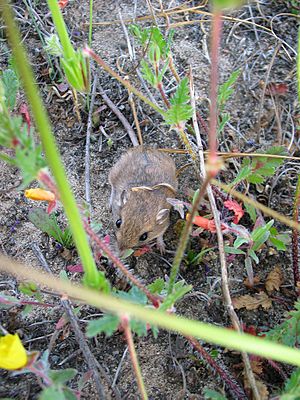Little pocket mouse facts for kids
Quick facts for kids Little pocket mouse |
|
|---|---|
 |
|
| Conservation status | |
| Scientific classification | |
| Genus: |
Perognathus
|
| Species: |
longimembris
|
The little pocket mouse (Perognathus longimembris) is a tiny rodent that lives in North America. It belongs to the family Heteromyidae, which includes other pocket mice and kangaroo rats. You can find these mice in Mexico (Baja California and Sonora) and in the United States (Arizona, California, Idaho, Nevada, Oregon, and Utah).
These small mice prefer dry, open areas like grasslands. They also live in places with scrubby plants. The little pocket mouse is quite common. Because of this, the IUCN says it is of "least concern". This means it is not currently in danger of disappearing.
Did you know some of these mice have been to space? Five little pocket mice traveled to the Moon in December 1972. They orbited the Moon 75 times aboard the Apollo 17 command module. Four of these brave mice survived their trip! Six more little pocket mice went into orbit with Skylab 3 in July 1973. Sadly, these animals died after only 30 hours due to a power problem.
Contents
Life and Habits of the Little Pocket Mouse
This mouse is quite small, but it has a long tail. It lives in dry and semi-dry places. These areas often have grasses, sagebrush, and other small bushes.
When They Are Active
The little pocket mouse is a nocturnal animal. This means it is active mostly at night. It is especially busy for the first two hours after the sun sets. After that, it moves around on and off throughout the night.
Seasonal Activity
These mice do not stay active all year. They sleep during the winter months. You will only see them moving around between April and November. Their numbers grow quickly in the spring. They are most common in June and July.
What They Eat
Little pocket mice are good at finding food. They look for seeds, bits of plants, and small bugs. When they find food, they carry it back to their burrow. They use their special cheek pouches to store and carry the food. It's like having built-in shopping bags!
Conservation Status
The little pocket mouse is found in many places. It is common across most of its home range. However, it is a bit harder to find in Baja California, Mexico.
Population Health
Scientists believe the number of little pocket mice is staying steady. There are no big threats that could harm this species. Because of this, the International Union for Conservation of Nature has checked on them. They have decided the mouse is of "least concern". This is good news for the little pocket mouse!


